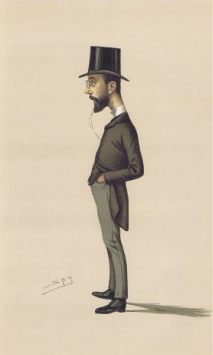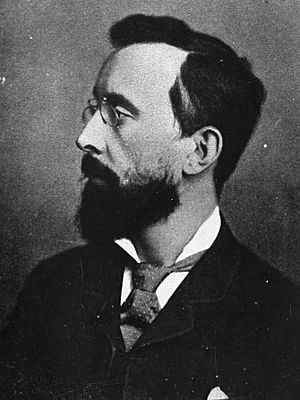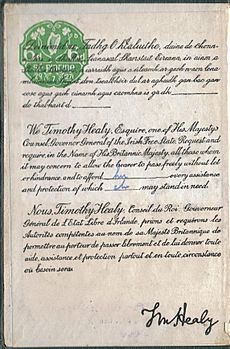Tim Healy (politician) facts for kids
Quick facts for kids
Tim Healy
|
|
|---|---|
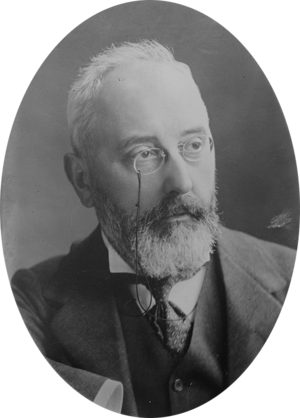
Healy, c. 1915
|
|
| 1st Governor-General of the Irish Free State | |
| In office 6 December 1922 – 31 January 1928 |
|
| Monarch | George V |
| Preceded by | New office |
| Succeeded by | James McNeill |
| Member of Parliament | |
| In office 1880–1918 |
|
| Personal details | |
| Born | 17 May 1855 Bantry, County Cork, Ireland |
| Died | 26 March 1931 (aged 75) Chapelizod, County Dublin, Ireland |
| Spouse | Erina Sullivan (m. 1882, d. 1927) |
| Profession | Politician |
Timothy Michael Healy (born May 17, 1855 – died March 26, 1931) was an important Irish politician, writer, and lawyer. He was known for being a KC, which means he was a very senior lawyer. Healy was also a Member of Parliament (MP) in the British House of Commons. His political journey started in the 1880s with Charles Stewart Parnell and continued into the 1920s. He became the first governor-general of the Irish Free State, a new country at the time.
Contents
Healy's Family and Early Life
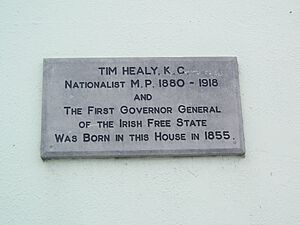
Timothy Michael Healy was born in Bantry, County Cork, Ireland. He was the second son of Maurice Healy and Eliza Healy. His older brother, Thomas Joseph Healy, and younger brother, Maurice Healy, also became Members of Parliament. They had a very close relationship throughout their lives.
His father worked as a clerk for the Bantry Poor Law Union, which helped poor people. The family was Catholic and had lost their lands a long time ago. In 1862, his father moved to Lismore, County Waterford, for a similar job.
Timothy went to a Christian Brothers school in Fermoy. He mostly taught himself by reading a lot. When he was 14, in 1869, he moved to Dublin to live with his uncle, Timothy Daniel Sullivan, who was also an MP.
Moving to England
In 1871, when he was 16, Healy moved to England. He found a job with the North Eastern Railway Company in Newcastle-upon-Tyne. There, he became very interested in the Irish Home Rule movement. This movement wanted Ireland to have its own government.
Later, in 1878, Healy moved to London. He worked for a factory owned by a relative. Then, he became a writer for The Nation newspaper, which his uncle owned. He wrote many articles supporting Charles Stewart Parnell. Parnell was a new and strong leader who wanted Home Rule for Ireland. Healy supported Parnell's idea of "parliamentary obstructionism," which meant slowing down laws in parliament to get what they wanted.
Parnell liked Healy's smart ideas and energy. Healy became Parnell's secretary. Parnell helped Healy become a candidate for the Irish Parliamentary Party (IPP). In 1880, Healy was elected to parliament without anyone running against him.
Healy's Political Career
In parliament, Timothy Healy was not physically big, but he was very smart and worked hard. He was also known for his strong speeches. He helped create the Healy Clause in the Land Law (Ireland) Act 1881. This important law meant that landlords could not charge extra rent for improvements that tenants had made to their land. By the mid-1880s, Healy was known for his sharp and sometimes harsh way of speaking.
In 1882, he married his cousin, Eliza Sullivan. They had three daughters and three sons. He had a happy family life, and his family was closely connected to the Sullivan family from west Cork.
Healy became known as a friend to farmers. He was even put in prison for four months because of a farming case. In 1883, he was elected as an MP for Monaghan. This was a high point in his relationship with Parnell. In 1884, he became a barrister, a type of lawyer. His good reputation helped him build a large legal practice, especially with land cases.
In the mid-1880s, farming prices dropped, and the weather was bad. Many farmers could not pay their rent and faced being kicked out. Healy came up with a plan to help farmers get their rents lowered. This plan was called the Plan of Campaign.
Disagreement with Parnell
Healy was a strong supporter of Parnell at first. But he became unhappy when Parnell chose Captain William O'Shea to run for election in Galway. Healy felt that Parnell was putting his personal life ahead of the country's needs. Healy believed the party should have been asked first. When Parnell went to Galway to support O'Shea, Healy had to back down.
In 1890, O'Shea sued his wife for divorce, and Parnell was named in the case. Healy and most of Parnell's friends stopped supporting Parnell as leader. They thought Parnell's actions were putting their alliance with the Liberal Party at risk. Healy became Parnell's strongest critic. His strong public attacks showed his traditional Catholic background. Many Irish people never forgave him for his role in this disagreement. This hurt his own standing in public life.
A nine-year-old schoolboy named James Joyce even wrote a poem about it called Et Tu, Healy?. Only a few lines of the poem remain:
His quaint-perched aerie on the crags of Time
Where the rude din of this century
Can trouble him no more.
Becoming Independent
After Parnell died in 1891, the Irish Parliamentary Party split. Healy was a strong voice in the group that was against Parnell. In 1892, he won the North Louth seat. However, he found it hard to work with any of the new leaders after Parnell. He was eventually removed from the party's main committee in 1895.
In the years that followed, Healy became less involved in politics because his legal work grew. He set up his own group called the "People's Rights Association." He held his seat as MP for North Louth until 1910. He often disagreed with the main Irish party leaders. However, he also played a part in helping the different party groups reunite in 1900.
Healy was very upset when his brothers and supporters were removed from the party's list for the 1900 election. His support for the reunited party was not rewarded. He was expelled from the party again two years later. He remained a critic of the party, finding other MPs who were unhappy to join him. He stayed in politics by working hard for his local area and through the help of his friend, Cardinal Michael Cardinal Logue. Healy was also connected to the "Bantry Gang," a powerful group from West Cork. This group included William Martin Murphy, a rich businessman who owned the Irish Independent newspaper. Murphy gave Healy a way to share his criticisms of the main Irish party.
New Alliances
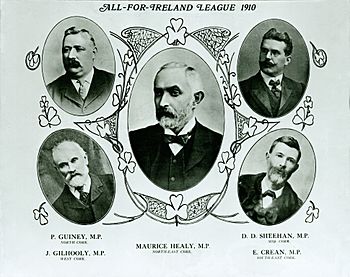
These are: Patrick Guiney (North Cork), James Gilhooly (West Cork), Maurice Healy (North-east Cork), D. D. Sheehan (Mid Cork), and Eugene Crean (South-east Cork).
The other MPs elected in January 1910 were: William O'Brien (Cork city), John O'Donnell (South Mayo) and Timothy Michael Healy (North Louth).
Maurice and Timothy Healy were brothers.
After 1903, Healy was joined in his disagreements with the party by William O'Brien. O'Brien had been a strong critic of Healy for years. But now, he also felt unhappy with the party's leadership. They formed a loose alliance that lasted for many years. They both believed that pushing too hard for land changes was not working. They preferred to try and make peace with the Protestant community to help Home Rule be accepted.
In 1908, Healy helped Arthur Vicars, a former official, in an investigation about the theft of the Irish Crown Jewels.
By the 1910s, it seemed Healy would remain a politician on the edge of the Irish nationalist movement. However, he became important again in the January 1910 election. He joined forces with William O'Brien's new All-for-Ireland Party (AFIL). Their main goal was to oppose the main Irish party. Healy lost his seat in the December 1910 election but soon rejoined O'Brien's group. Healy's reputation was not helped when he represented William Martin Murphy, an industrialist who caused the 1913 Dublin Lockout, a major workers' strike.
Changing Sides
The main Irish party, led by Redmond, had a lot of power in the British Parliament. They were close to getting the Third Home Rule Bill passed. This made Healy and the AFIL critics less powerful. They said the bill would divide Ireland and did not vote on it. When World War I started in 1914, the Healy brothers supported the British war effort. Timothy's oldest son, Joe, fought bravely in the war.
After the Easter Rising in 1916, Healy believed that the main Irish party and Redmond were finished. He slowly stepped back from politics. In 1917, he showed support for Arthur Griffith's Sinn Féin movement. However, he did not agree with using violence. In September 1917, he acted as a lawyer for the family of Thomas Ashe, a Sinn Féin hunger striker who died. He was one of the few senior lawyers who helped Sinn Féin members in legal cases after the 1916 Rising. This included helping those held in the Frongoch internment camp in Wales. Before the December 1918 general election, he was the first AFIL member to give up his seat to a Sinn Féin candidate. He spoke in support of P. J. Little, the Sinn Féin candidate for Rathmines in Dublin.
First Governor-General
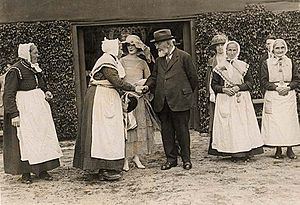
Healy became very important again in 1922. The new Irish Free State's government, led by W. T. Cosgrave, asked the British government to recommend Healy. King George V then appointed him as the first 'Governor-General of the Irish Free State'. This was a new role created by the Anglo-Irish Treaty of 1921. The Governor-General was the King's representative in Ireland. Healy was also the uncle of Kevin O'Higgins, a key minister in the new Free State government.
At first, the Irish government wanted Healy to live in a smaller house. But because of threats from the IRA, he moved temporarily into the Viceregal Lodge. This was the former home of the Lord Lieutenant of Ireland, who was the King's representative before 1922.
Healy officially started his job as Governor-General on December 6, 1922. He never wore the official uniform that other Governors-General in the British Empire wore. He was also unique because he was never made a member of the Imperial Privy Council. This meant he did not get the special title 'The Right Honourable'.
Healy was a good Governor-General. He had political skills, understood politics well, and had good connections in Britain. These qualities were helpful for the new Irish government. He once joked that he advised the government, not the other way around. This comment caused some public criticism. Healy also caused controversy by publicly criticizing the new Fianna Fáil party and its leader, Éamon de Valera. This led to calls for him to resign.
Healy was a key link between the governments in London and Dublin. He had access to important state papers. He also received instructions from the British Government on how to use his powers. For example, he was told to reject any law that would get rid of the Oath of Allegiance. However, no such laws were introduced during his time in office. In the mid-1920s, the role of the Governor-General changed. They became only the King's representative and the head of the Irish executive, no longer acting on advice from the UK government.
Healy seemed to think he would be Governor-General for life. However, in 1927, the Irish government decided that Governors-General would serve for five years. So, he retired from the job and public life in January 1928. His wife had died the year before. He published his long memoirs in 1928. Throughout his life, he was known for being very quick-witted and not afraid to challenge social or political rules. Towards the end of his life, he became more diplomatic.
He died on March 26, 1931, at the age of 75, in Chapelizod, County Dublin. He was buried in Glasnevin Cemetery.
Cultural Depictions
In his book The Man Who Was Thursday, writer G.K. Chesterton describes one of his characters as a "... little man, with a black beard and glasses – a man somewhat of the type of Mr Tim Healy ...".


